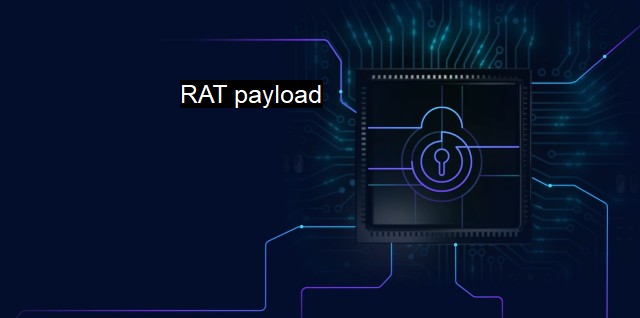What is RAT payload?
Rampant RAT Payloads: An Increasing Danger for Cyber Security
A Remote Access Trojan (RAT) payload presents a potential cyber security threat in the digital world, which often elicits deliberation and analysis by cyber security experts and antivirus software developers. A RAT Payload is the harmful component that makes a RAT dangerous. Delving into the specifics excellently illuminates why it's a matter of grave concern in modern day cybersecurity.A Remote Access Trojan (RAT) alone can be termed as a piece of malicious code or software that deceives the victim into installing it for the attacker to gain remote access control over the system. In a broader implication, it permits unauthorized users to access the host device, causing substantial potential for damage or threat to the user's security, privacy, and data. They are explicit tools engineered to pave the way for hackers to intrude, control and exploit the target computer systems secretly.
Yet, a RAT becomes more potent and harmful due to the accompanying RAT payload. The RAT payload can be a program, scripts, or a command used by intruders ostensibly to deliver a package while simultaneously creeping into the host system to exploit its vulnerabilities. the payload is the cargo; the harmful material or data secretly enwrapped by the infected RAT. Analogically, if RAT is like a carrier or deliverer, then payload would be the malicious item it carries.
The idea behind a RAT Payload can vary with the specific intent of the attacker. A RAT payload could enable the attacker to manipulate the files on the host computer, install additional software, or even change the settings for particular applications. Imagine a scenario when payloads allow hackers to covertly monitor the host system's activities, alter critical settings, distribute spam emails, involve in "click fraud" campaigns, initiate Distributed Denial-of-Service (DDos) attacks, or oversee keystrokes for theft of sensitive data and information.
Payloads could further arm the attacker to disable the antivirus software, mask their intrusion, exploit weaknesses in operating system software, or implement measures that wipe distinct files or data. Unfortunately, they execute these tasks without leaving a trace, making detection and countermeasure even more challenging.
Antivirus solutions play a critical role in the defense against RAT payload threats. They are designed to recognize the typical patterns and behaviors linked to these types of attacks. Like recognizing a specific signature to a RAT payload, they hold the potential to ward off initial intrusions, anticipate further moves, and ensure timely termination of suspicious processes. Enforcement of heuristic analysis becomes baseline practice to detect behavior based RAT payloads that do not fall under known-signature files.
It's noteworthy that avoiding RAT payload attacks is more than just having a high-grade antivirus solution. Awareness about potential vulnerabilities, predictability, diligent monitoring, and good cyber hygiene practices, from avoiding unfamiliar links to regularly updating software, are equally indispensable.
a RAT Payload is an integral part of the malware ecosystem that complicates the panorama of digital safety as it pivots around clandestine exploitation of the host computer. It's a quintessential threat domain where cybersecurity intersects with RATs, prompting protective initiatives from system developers, antivirus solution providers, and infrastructural rehabilitators for the cybersecurity world. Understanding the complexities surrounding the RAT Payload, therefore, becomes foundational in the relentless endeavor to secure digital spaces, individual and corporate data alike.

RAT payload FAQs
What is a rat payload?
A rat payload is a malicious software that allows cybercriminals to gain unauthorized access to a victim's computer or network. A rat payload typically includes a remote access tool (RAT) that enables an attacker to remotely control the victim's system.How does a rat payload work?
A rat payload typically arrives on a victim's computer or network in the form of an email attachment, a corrupted file, or a software exploit. Once the rat payload is activated, it installs a RAT that establishes a connection between the attacker and the victim's system. The RAT enables the attacker to access files, monitor activity, and perform other malicious actions on the victim's computer.Can antivirus software detect a rat payload?
Antivirus software can often detect and remove known rat payloads. However, cybercriminals are constantly developing new and more sophisticated rat payloads that can evade detection by traditional antivirus tools. It is important to keep your antivirus software up to date and use additional cybersecurity measures, such as firewall protection, to help prevent rat payloads from infiltrating your system.How can I protect my system from a rat payload attack?
To protect your system from a rat payload attack, you should practice good cybersecurity hygiene such as avoiding suspicious emails or attachments, using strong passwords, and keeping your antivirus software up to date. Additionally, it is important to use a firewall and to limit user access to critical systems and data. Always stay informed about the latest threats and cybersecurity best practices to help prevent rat payloads and other types of malicious software from infiltrating your system.| | A | | | B | | | C | | | D | | | E | | | F | | | G | | | H | | | I | | | J | | | K | | | L | | | M | |
| | N | | | O | | | P | | | Q | | | R | | | S | | | T | | | U | | | V | | | W | | | X | | | Y | | | Z | |
| | 1 | | | 2 | | | 3 | | | 4 | | | 7 | | | 8 | | |||||||